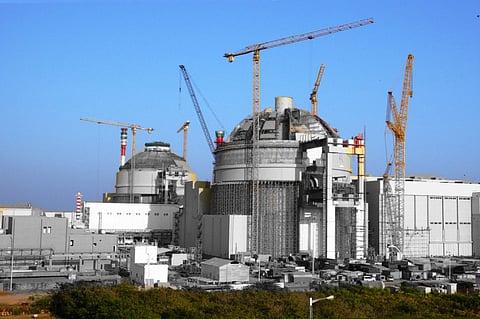

The Kudankulam Nuclear Power Project (KKNPP) in Tamil Nadu, a collaborative project between India and Russia already has two functional reactors. During the ongoing Brics summit in Goa, Vladimir Putin and Narendra Modi would formally inaugurated the ‘base concreting work’ in the deep trench dug for the third and fourth reactors through a video conferencing on Saturday afternoon.
More reactors?
In a recent agreement between India and Russia, it has been finalised to set up five and six units at the Kundankulam power plant in Tamil Nadu.
The Economic Times states that the official announcement will be made after bilateral talks between Prime Minister Narendra Modi and Russian President Vladimir Putin in Goa during BRICS summit on Saturday.
Sources from the Kudankulam Nuclear Power Plant told The Hindu that the ‘First Pouring of Concrete’ for both the third and fourth reactors will begin during the first quarter of next year.
Nuclear Power Corporation Of India Limited (NPCIL) is expected to finish the construction of third and the fourth reactors at a cost of Rs. 39,747 crores. Both the reactors will be taken to criticality by 2022.
History
KKNPP, the highest capacity generating nuclear power plant in India, has a history spanning across three decades, with protests marring its implementation.
The agreement was signed in 1998 by the then Indian Prime Minister Rajiv Gandhi and Soviet President Mikhail Gorbachev.
The initial agreement was to set up two nuclear reactors in Tirunelveli in Tamil Nadu that will make the country self-sufficient in nuclear-powered energy.
1st crisis: In 1990, nearby residents and the fishing community protested over the diversion of water for the reactors from the Pechiparai dam in Kanyakumari district.
2nd crisis: The dissolution of Soviet Union in the year 1991.
The construction work resumed in 2000 in Tamil Nadu under the Atal Bihari Vajpayee government.
In 2004, a port was constructed for transporting raw materials to the plant and the decision to set up four more reactors came four years later.
The operations of the first nuclear power unit began in 2011.
3rd crisis: Major protests broke out in 2011-2012 after Fukushima Daichii nuclear disaster in Japan raising concern over the safety of the Kudankulam plant. Many argued that nuclear energy was not a solution to overcome the power crisis in Tamil Nadu.
As many as 1800 protestors were arrested in October 2012 from Chennai.
The protestors led by green activist S. P. Udayakumar and his People's Movement against Nuclear Energy, invited sedition charges against them. Protesters from Kerala also joined in.
Kudankulam is just 60 kms from Thiruvananthapuram and in case of a nuclear accident, Thiruvananthapuram, Kollam and Pathanamthitta districts would be affected besides the districts of Tamil Nadu.
In 2012, Executive Director (Light Water Reactors), Nuclear Power Corporation of India Limited said that water will not be drawn from the Pechipaarai dam or the Tamirabharani.
“Since we've installed two desalination plants to meet the drinking water requirements of Anu Vijay township (where KKNPP personnel reside) and also the KKNPP site, we will never draw water from the Pechipaarai dam in Kanyakumari district or the Tamirabharani, lifeline of southern districts, at any point of time in future. The fears expressed by some people are unfounded,” said Mr. Balaji, who has been elevated as Executive Director (Light Water Reactors), Nuclear Power Corporation of India Limited.
In 2013, the power plant reached criticality.
The first unit of the nuclear power plant reached full capacity generation of 1000 MW in 2014, of which Tamil Nadu’s share of power is 465 MW.
In December 2014, India and Russia decided to construct at least 12 more units in India.
In 2014, a pipe burst accident in the feed water system of the plant left six workers with severe burn and musculo-skeletal injuries.
In February 2016, Nuclear Power Corporation of India Ltd. began soil excavation and preparation of pits for construction of Units 3 and 4.
Construction work of Units 3 and 4 will begin on Saturday.